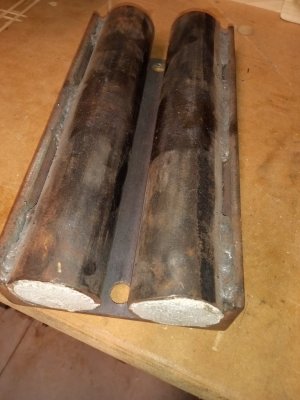No, I can't get you pictures, because I carried the good one to work years ago when the fellow who had one left us, and took his with him... I can show you the prototype that I still use at home to this day. And while this approach to building one could still be quite useful, I'm thinking (not knowing, just thinking) you might have to limit the material some, because you might just have enough press there to find some limits....
This one (prototype, not ideal) has several issues. First, the attachment to the press is too tall, as my Harbor Freight press has a crooked little dingus end under the jack, so it's oversized, with two screws to keep it level. And second, the alignment bars are too long. So the only practical way to set it up (which works well ONLY if your blocks are square...), is to set it up awkwardly high. Otherwise you've got to set it up and move the table up a notch. And last, the big one, I was guessing at sizes. What you see here is literally two pipes, welded in to a piece of channel. And filled with expanding grout. Or maybe hydraulic cement. Something like that. They're stout (and pointed well away from the operator while in case that crap was gonna explode out the ends of the pipe, but it's well vetted at this point....) But they're too big, the gap isn't enough. That limits it to quarter inch steel, and it starts to press geometrically harder as that comes towards 90 degrees, so that's the max.
Here's what I did different with the final one- Which I could soon enough get pictures of if you want/need that- First, it's on a different press that (almost literally) uses a porta-power ram, so the "guillotine thing" is made to just fit into the end of that nicely, and hold in with the same set screw that holds the original flat end. I elected to NOT use alignment bars, I don't mind the manual alignment, and that makes it quicker to set up for the one time bends that I tend to do. (I'm in repair more than fabrication). But clearly this is home brewed stuff, so whatever works... The base, that worked out VERY well with a standard 5 inch channel, and a pair of 1.500 solid bars. I used old cylinder rod, that's held up amazingly well. Instead of welding them in, I just countersunk a couple of screws into each one from the bottom, 'cause "where's it gonna go". That's more to keep it together in storage than it is to keep it in place when you're pressing. You've still got to get an apron plate or two under it, but it sets up and sits nicely with the plates laid down flat like they oughtta be. That dimension between the bars (I've never measured it), with the standard 5 inch channel and two 1.5 inch rods, it bends 3/8 stock with confidence to well past 90 degrees, until the work piece gets wider than the press can bend, and still is narrow enough to bend a "reasonably" short piece, as well as adequately support thinner material..
As I said, I'm not 100 percent sure how that would scale to a larger press. But on the other hand, I use this prototype a lot more than I ever thought I'd use a finished one. It's done pretty well for me at home, where the opportunity for bending larger than quarter inch stuff really doesn't tend to come up much... Although if/when I address the crooked dingus on my Harbor Freight press, I will remake the top of the prototype one as well, as that alone is my biggest dissapointment in it. Not a big enough dissapointment to do anything about it (yet), but it'd be awful nice not to choose between standing up the apron plates, or moving the apron up a hole with the bender installed and assembled, and then having to reverse that to get it back out.
 And I'm curious if anyone has used this sort of accessory (or similar brake) with decent success? TIA
And I'm curious if anyone has used this sort of accessory (or similar brake) with decent success? TIA




